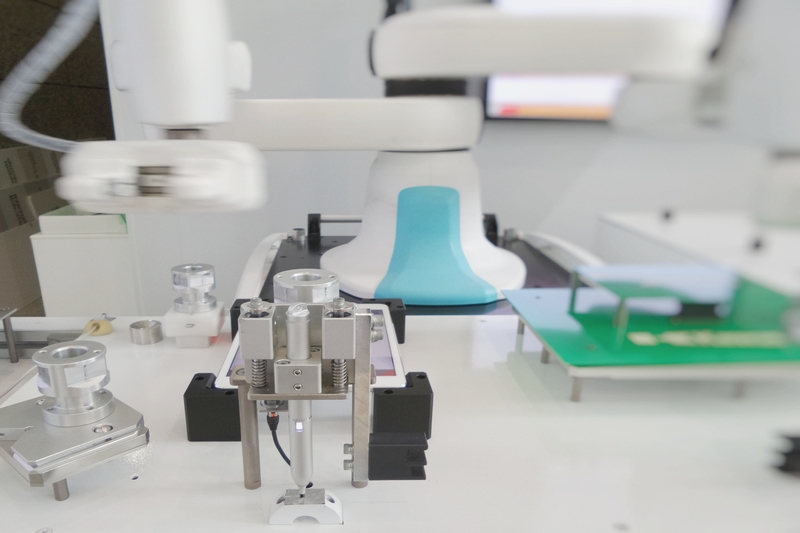Industrial Robots Vs Cobots: What’s Their Difference? - Nairaland / General - Nairaland
Nairaland Forum / Nairaland / General / Industrial Robots Vs Cobots: What’s Their Difference? (178 Views)
4 AI Robots Killed 29 Humans In Japan: The Truth Behind The Fake News / U.K Factory Produces Humanoid Robots That Functions Like Human And Us [pictures] / Total E&P Nigeria SIWES Industrial Training Past Questions And Answers (2) (3) (4)
(1) (Reply)
| Industrial Robots Vs Cobots: What’s Their Difference? by kashitarvadi(m): 1:49am On May 27, 2020 |
 Photo by Franck V. on Unsplash Adding a robot to your business can improve efficiency, reduce operational costs, and increase productivity. However, when purchasing a robot, businesses are faced with the question of which one to go for. This is because there are both industrial and collaborative robots in the markets. Each category has its own unique selling points and selecting a suitable choice can be confusing for most enterprises. This is why buyers should find out how industrial robots and collaborative robots (also known as cobots) differ in terms of initial price, maintenance costs, and programming. Initial Costs Before diving into the cost, it will be helpful to understand what cobots are. Cobot is the name given to a group of robots that are usually unguarded and very easy to integrate. They automate recurring and unsafe tasks in a business thus allowing human workers to carry out high-value tasks. Unlike industrial robots, cobots don’t perform manual tasks such as picking and dropping items down-/upstream. When compared to industrial robots, acquiring a cobot is inexpensive. Their low cost has made it possible for small businesses to access robots. Of course, a business should not just choose a cobot because it’s inexpensive. There are other important considerations to make before settling on a robot. For instance, cobots operate under a safety standard that dictates that its speed is inversely proportional to the load. This means, its speed reduces as the load increases and this can greatly impact the ROI. The industrial robots, on the other hand, are heavy-duty and come with large payloads. This makes them suitable for heavy applications. For instance, robots like 6-axis and SCARA are known to perform some of the dangerous and repetitive tasks around. These include picking and dropping heavy items and assembling parts. They also boast very high speeds. Because of their design and capabilities, industrial robots come at a higher initial cost. But since they can perform tasks fast, companies will look at the increased return on investment. The fact that industrial robots can work at higher speeds and do more in a short period is a win for many industries. Running costs When considering these machines, businesses need to factor in the cost of ownership. Any robot will require some level of maintenance, energy, and peripherals that work with the robot. For instance, a business may do a risk assessment and discover that they need to invest in force limiters or additional fencing to ensure the equipment is safe to use around people. A good example is where you find a cobot that uses a knife as an end effector. Such a machine will call for caging for people to work safely around it. Another aspect that will influence the cost of ownership is the machine’s energy consumption. To get a true standing of the cost, it’s important to compare energy consumption and production output. Think of a machine that consumes 800W of energy to produce a single unit. Then compare it with another that consumes 3000 W to process 10 or more items within the same time. Which one is energy efficient? Industrial robots fall in the second category. Ease of Programming When businesses are purchasing robots, one of the important considerations they make is how easy it is to program it. This is because a machine that users can program is easy to adapt to specific needs. By design, cobots are easier to program than industrial robots. In fact, cobots are marketed as intelligent and capable of learning on the job. Since they also work alongside human workers, the operator can guide cobot through a new routine by manually moving their hands. Such option is available for example in Rozum Robotics cobots . There is also another aspect of easy programming that makes collaborative robots popular. Ease of programming enables both inexperienced and experienced users to program the machines within a short time. This has proven beneficial to small and medium-sized enterprises that are still trying to adapt to automation without the capacity to hire highly skilled programmers that can handle complex programming needs. When compared to cobots, industrial robots are generally laborious to program. But there’s still hope for small and medium-size businesses that want to capitalize on the power and speed of industrial robotic designs. They will soon do so without foregoing the ease of programmability of a robot. Manufacturers of modern industrial robots are increasingly shifting to designs that are easy to program. Conclusion Looking at the differences keenly, you’ll realize that both industrial and collaborative robots have strong selling points. Additionally, manufacturers of each category seem to be working hard to correct the long-held limitations of each. For instance, today’s industrial robots are shifting the perception about costs and ease of programming, while cobots manufacturers are looking for ways to improve productivity and ROI. Eventually, a business will easily decide which robot to purchase by looking at specific applications. 1 Like |
(1) (Reply)
Week 47 Aussie 2020 / Does The Minister Work For A Chinese Company? / Get In Here If You Can Write!
(Go Up)
| Sections: politics (1) business autos (1) jobs (1) career education (1) romance computers phones travel sports fashion health religion celebs tv-movies music-radio literature webmasters programming techmarket Links: (1) (2) (3) (4) (5) (6) (7) (8) (9) (10) Nairaland - Copyright © 2005 - 2024 Oluwaseun Osewa. All rights reserved. See How To Advertise. 16 |